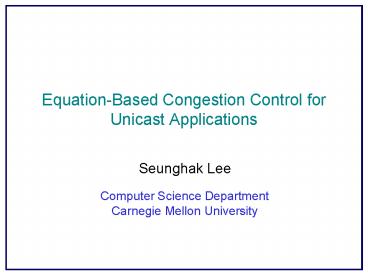Equation-Based Congestion Control for Unicast Applications PowerPoint PPT Presentation
Title: Equation-Based Congestion Control for Unicast Applications
1
Equation-Based Congestion Control for Unicast
Applications
- Seunghak Lee
- Computer Science Department
- Carnegie Mellon University
2
End-to-End Congestion Control
- Additive Increase/Multiplicative Decrease
approach - Congestion control used by TCP
- If congestion is detected (e.g. packet drop),
multiplicatively decrease congestion window size
(CWZ CWZ / 2) - Otherwise, additively increases congestion window
size (CWZ CWZ 1) - Equation-based congestion control approach
- Adaptively controls sending rate according to
control equation - Slow response to the congestion
3
End-to-End Congestion Control
Advantage Disadvantage
AIMD (TCP congestion control) Effective for bulk data transfer Multiplicative decrease is not suitable for real-time applications (e.g. streaming multimedia)
Equation-based congestion control Change of transmission rate is smooth over time (appropriate for real-time applications) Not able to respond to the abrupt increase immediately
- TCP-friendly Rate Control (TFRC)
- Proposed equation-based congestion control for
unicast application - Smooth change of sending rate in response to
congestion
4
TCP-Friendly Rate Control (TFRC)
- TFRC is TCP-compatible
- If TCP and TFRC were competing, there is no
significant starvation in FIFO queue - TFRC uses TCP response function (it reflects the
steady-state sending rate of TCP) - Design principles
- 1. Not aggressive for sending more data
- 2. Be responsive to packet losses in sufficiently
long term
5
TFRC Protocol
TCP response function
T upper bound of sending rate
p steady-state loss event rate
computed by receiver
R round-trip time
tRTO retransmit timeout
computed by sender or receiver
can be computed using R
6
TFRC Protocol
- Receiver
- Computes p (loss event rate) and transfer it to
the sender - Sender
- Compute T based on p and R
- Controls transmission rate based on T
7
TFRC Protocol
- Loss event rate (p)
- Different from loss fraction which is
- Loss event rate counts a event loss per packet
round-trip time - Loss event rate models TCP protocols
- Average Loss Interval method is used.
(Averaging the loss rate over the previous loss
intervals with dynamic weights)
8
Summary
- Equation-based Congestion control is proposed for
real-time applications - Sender determines the transfer rate (T) based on
the control equation - Receiver computes loss event rate which is
transferred to sender and used to compute T - TFRC provides congestion control mechanism which
is less variable in response to congestion

